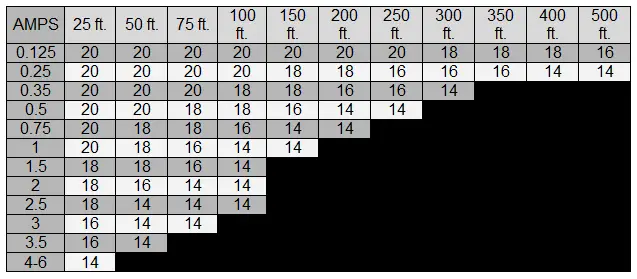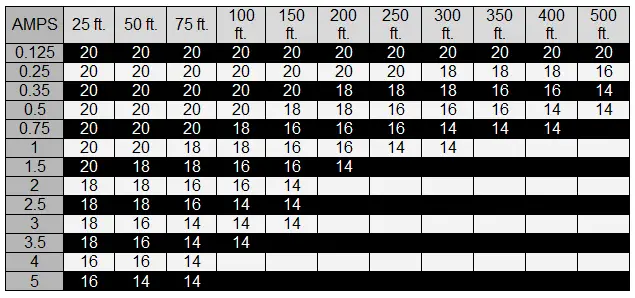This guide will discuss the difference between 12v and 24v wire sizing and the cost comparison between the two. There are many uses for each type of wire and savings that can be applied with different wiring sizes that we will talk about.
We’ll also discuss some common, frequently asked questions about wire sizes, voltages, and other related topics.
Let’s jump into it!
VOLTAGE AND AMPERAGE BREAKDOWN
When it comes to voltage and amperage, the more voltage you have in a system, the better the system will run in most scenarios.
Think about a car: if you want that car to get up to 60 mph fast, you’ll need more horsepower in the engine. For electric vehicles, you’ll need more power from the battery to feed into the motor, which turns into energy.
Power is mathematically described as voltage multiplied by the amperage. If you have 40 amps, for example, from a 12V battery, you’ll end up with 480 Watts, but with a 24V battery, you’ll have 720 Watts, which is double what you had before.
The amperage causes heating which means that your entire system will get hot, which wastes usable power. Mathematically, the heat wasted is proportional to the square of the resistance multiplied by the current—the losses on a 24V battery would be half of what they would be on a 12V battery.
In most cases, a 24V system is better than a 12V system because it's cheaper, here is why:
WHAT SIZE WIRE SHOULD I USE FOR 12V AND 24V?
Imagine that you’re blowing up a balloon with your mouth: it would be effortless to fill that balloon up, right? Now imagine blowing through a 100-foot long straw. It would be a lot harder since air would start to show resistance pretty quickly as it travels through the straw.
Power works similarly. For systems that have wires that are less than 5 feet in length, there’s barely a difference in using any sort of wire for a given amperage, but for wires that go from 25 feet to 500 feet in length, you have to know which size wire is the right one for you.
Just follow the two charts below for the appropriate wire gauge size for the corresponding amperages:
Minimum Wire Gauge Size for 12 Volts

Minimum Wire Gauge Size for 24 Volts

COST OF WIRING

The cost of wiring entirely depends on the length, the type, and the size of wiring that you’d like.
Generally speaking, 24V is much cheaper than 12V because 12V system requires thicker cables to carry the amperage load, and copper wires are NOT cheap.
For example, if you have a 12V system, you’re expecting a current of 3 amps, and you’d like a 25-foot wire, you’ll want a minimum wire gauge of 16 gauge. If you buy any thinner, such as 18 or 20 gauge, you may not be able to supply the target with enough power.
From there, the type of wire depends on what’s suitable for your system. A silicon wire is the most typical type, but you can also buy parallel silicon, silicon ribbon, multicore silicone, PVC, or magnet wires, depending on what’s best for you.
Here is a table of 10-foot long silicon wire costs for reference from BNTechGo:
As you’re able to see, after 16 gauge, if you would like thinner wire sizes, there is no price difference until 22 gauge, and even after that, the price stays the same to go narrower.
According to the wire size tables above, our recommendation is to go with the thickest cable within your budget. The cost difference is not much, and you’ll save power in the long run by using the 24V wire size recommendations instead of the 12V unless you’re strapped for money.
WHEN SHOULD I PICK 12V OVER 24V?
It may seem like we favor 24V systems always, but there are benefits to 12V systems.
Having a 24V system is that it dramatically reduces the wiring cost to almost half the original price. 24V supplies are more compatible with AC appliances.
The disadvantage of having a 24V supply is that not all appliances operate on this system. Domestic systems, such as telephone equipment and controllers, work on 12V systems. Sometimes, it is safer to use a 12V system if you intend to run appliances directly from batteries, as it’s at a safer voltage for DC circuits.
COMMON FAQS
Does voltage matter for wire size?
The system’s voltage has no bearing on the wire’s size, but the voltage does dictate the quality of a wire’s insulation. It's an amperage that you’d have to worry about when it comes to wiring size and power.
Most household guides online will suggest using 14-gauge wiring for 15 amp circuits, 12-gauge wiring for 20 amp circuits, and 10-gauge wiring for 30 amp circuits. In some cases where 14-gauge wiring is more appropriate, users have used 12 gauge instead since it’s easier to work with and it costs less than premium 14 gauge wiring.
How do I calculate what size wire I need?
Choosing the correct wire size is crucial for safety hazards and performance issues of the system. Wire size depends on the current and the length of the wire. Even if your neighbor is installing a refrigerator, and so are you, you’ll most likely need a different wire gauge.
Luckily, there are a lot of online calculators that tell you exactly what wire size and type are perfect for you. For example, FarOutRide has a wire calculator that will tell you the kind of wire and size if you enter the load current, wire length, and the voltage drop into the calculator.
What is voltage drop, and how does it affect picking between 12V and 24V?
Voltage drop is the decrease of electrical voltage along the path of a circuit. Excessive dropping is due to increased resistance in a circuit from an overload or energy being used in lighting.
Voltage drops are sometimes expected and intentional, but dealing with them is crucial but easy. The rule of thumb with voltage drops is to calculate how much the voltage is decreasing by.
For example, if the system had 24V before and now, it’s showing 22V, a decrease, or a voltage drop, of 8.33%. Usually, voltage drops are 1%-3%, but they should be taken into account for. The online calculator mentioned above has a voltage drop category that takes the decrease into account.
Another way to account for the voltage drop is to use the higher voltage value for wire sizing. That way, you’re only using a wire meant for a higher push and not for lower power.
What size wire should I use for a 200 amp device?
More information will be needed besides the device’s current, but standard variables are applicable for most cases.
If you have a 24V supply for a 200 amp device, we will assume that the wiring is copper and has a typical insulation and installation type. With a wire distance of 25 feet and a voltage drop of 3%, you will need a wire size of 4/0 AWG.
The online calculator, WireSizeCalculator, is a fantastic tool that’s useful for finding out the correct wire sizes for your specific system.
Does cable length matter?
The cable’s length is significant but only when dealing with wires more extended than 15-20 feet. For wires that are 5-10 feet long, the wiring size is usually standard for most cases—switching from a 12-gauge to a 16-gauge won’t affect your system enough for you to notice.
However, if we’re dealing with wire lengths of 200 feet or more, wiring thickness is vital! By following the charts that are listed above, you’ll be able to utilize almost all of your available power correctly and not have any be suppressed or resisted just because of the wrong type of wiring.
KEY TAKEAWAYS
- There is a massive difference between 12V and 24V systems
- 24V systems and wiring are better in almost every scenario
- Always get a gauge size bigger than the recommended wiring (it will be easier and sometimes cheaper to work with)
- Look up the type of wiring needed for your specific project—most projects will be standard, but for underground, underwater, cold-temperature, and other cases, different wires, and coverings will need to be used
- Amperage affects the wire size; voltage affects the quality of power
- There are many online wire size calculators
- Cable length matter when dealing with wire sizes greater than 20+ feet
We hope this guide helped you grab your wire type for your next project! Wiring can get expensive and complex depending on how big the project is, and for solar-related projects, wire lengths can exceed 100-200 feet easily, depending on the type of house.
Good luck, stay safe, and go green!
